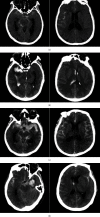CTA Study of Ruptured Aneurysms of the Posterior Communicating Artery
- PMID: 36160068
- PMCID: PMC9492435
- DOI: 10.1155/2022/5774735
CTA Study of Ruptured Aneurysms of the Posterior Communicating Artery
Abstract
Background: Only a few reported studies have used computed tomography angiography (CTA) to image ruptured aneurysms at the junction of the internal carotid artery (ICA) and posterior communicating artery (PcomA) in the context of the adjacent arteries. Therefore, we performed such a study using a GE Workstation.
Methods: The parameters of each aneurysm and its adjacent arteries were measured. Then, statistical assessments were performed to compare the parameters of the aneurysm side and the lesion-free (control) side.
Results: Sixty-three patients were included in this study. The average age was 62.1 ± 11.0 years, and the ratio of males to females was 0.8 : 1. The measurement results showed that the mean aneurysmal height was 5.2 ± 2.3 mm, the mean width was 4.7 ± 2.2 mm, and the mean neck width was 4.5 ± 1.9 mm. On the aneurysm side, the intradural ICA diameter was 4.34 ± 0.90 mm, and the diameter of the ICA at its termination was 3.55 ± 0.72 mm. A fetal-type PcomA was found in 52.4% of aneurysms. The other measured parameters were also provided. Statistical results showed that the height of the aneurysm was larger than the width (P < 0.05). The intradural ICA diameter, the ICA diameter at termination, the intradural ICA length, and the angle between the ICA and PcomA were larger in the aneurysm group than in the control group (P < 0.05).
Conclusions: This CTA study showed that the ruptured PcomA aneurysm was often wide-necked, nonspherical, and approximately 5 mm in size. In the presence of a ruptured PcomA aneurysm, the affected intradural ICA became thicker and longer than the contralateral control ICA, and the aneurysm significantly reduced the angle between the ICA and the PcomA.
Copyright © 2022 Zibo Zhou and Jinlu Yu.
Conflict of interest statement
The authors declare that they have no competing interests.
Figures




References
-
- Niibo T., Takizawa K., Sakurai J., et al. Prediction of the difficulty of proximal vascular control using 3D-CTA for the surgical clipping of internal carotid artery-posterior communicating artery aneurysms. Journal of Neurosurgery . 2020;134(3):1165–1172. doi: 10.3171/2020.1.JNS192728. - DOI - PubMed
LinkOut - more resources
Full Text Sources
Miscellaneous

